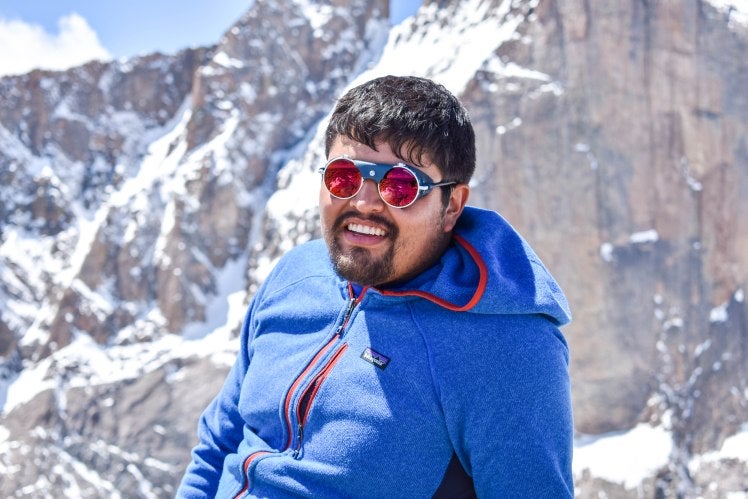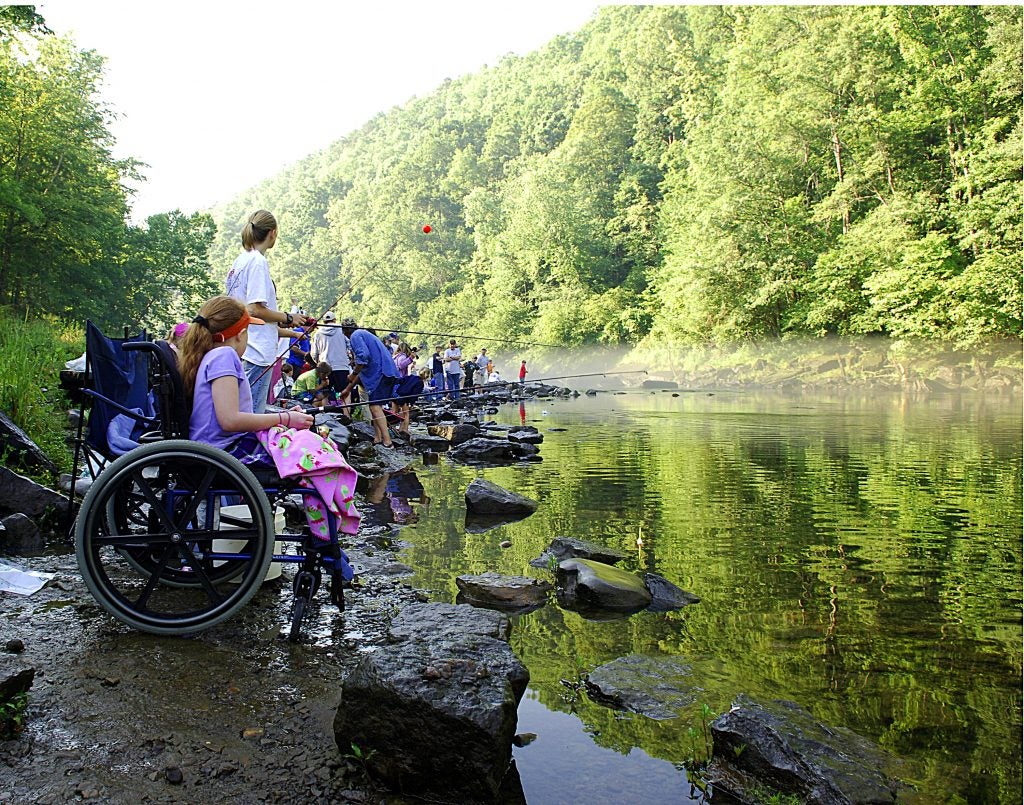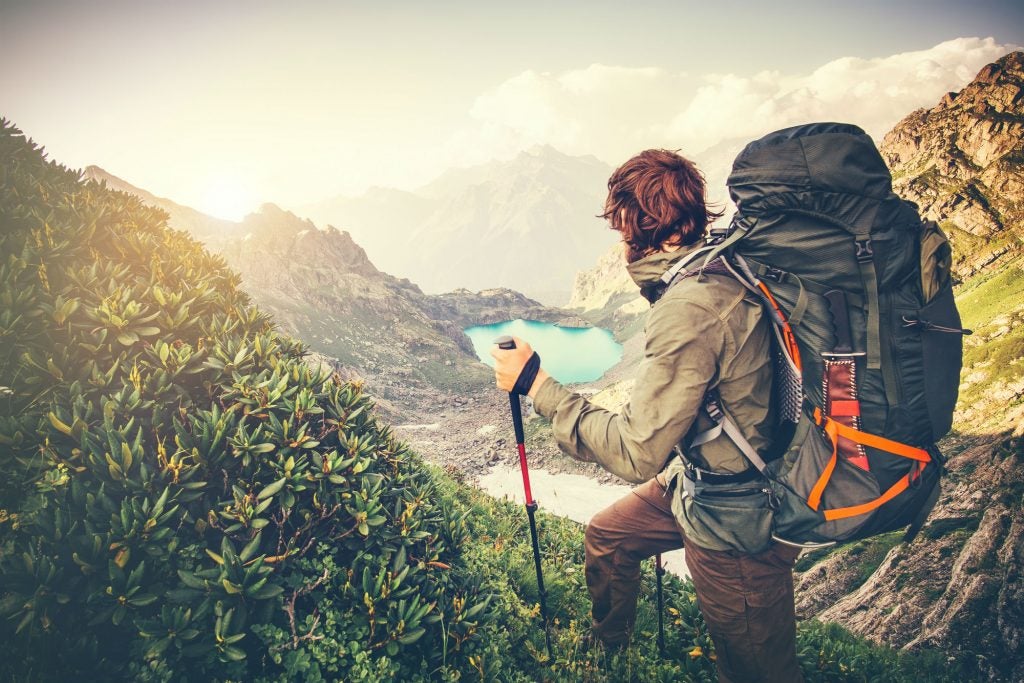A conversation with Len Necefer, founder of NativesOutdoors, on advocacy for public lands and native rights.
If you’ve recently been inspired to visit Bears Ears National Monument, or Grand Staircase-Escalante, you’re not alone. These stunning desert regions of Utah took center stage in a heated political debate over public lands last year. Suddenly photos of sweeping red rock landscapes were on the news — many people hadn’t heard of them until President Trump decided to shrink their boundaries of protection.
Climber, engineer, and activist Len Necefer has become a prominent figure in those conversations on social media and in the outdoor industry. And he’s offering a native perspective that is sorely lacking in the outdoor recreation scene. Through NativesOutdoors gear and social media presence, Len is bringing indigenous voices to the forefront of conversations surrounding land that was theirs in the first place.
The Dyrt caught up with Len to discuss issues surrounding public lands, and to offer outdoor enthusiasts some insight on how to respectfully enjoy them.
The Dyrt: When did you start NativesOutdoors and how has it evolved since the beginning?
Len: I started NativesOutdoors in March of 2017.
Originally the idea started as an Instagram account, simply to share stories & photos of indigenous people in the outdoor recreation scene. However, this quickly evolved into developing gear and clothing as it became clear that there weren’t any native-owned gear and clothing businesses in the industry.
Now we are positioning ourselves as a company that uses the gear as a means for advocacy on issues that we care about, such as Bears Ears & the Arctic Refuge – issues that directly affect indigenous people.
How does your work around NativesOutdoors affect your own community?
I am a member of the Navajo Nation. There have been a few ways in which NativesOutdoors has positively affected my own community. Namely in outdoor media, voices and faces like my own, rarely if ever show up and we have noticed. The platform that we created provides a means for us to change this visual narrative.
The announcement of reductions to Bears Ears and Grand Staircase Escalante was a blow to many. What are some lessons you’ve taken away from the experience of fighting for protection of these places so far?
The indigenous stories of these lands can be made relatable and interesting for the broader community that supports the protection of these places.
The history education we receive in the United States surrounding native people does a poor job of providing indigenous perspectives, and it often provides a narrative that can be harmful to the coalitions needed to protect these places.
At the end of the day, we’re simply the products of our education system and how it teaches this history. The fight to protect these public lands has led many folks to begin questioning the things that they were taught in school and seeking more information to fill the gaps. I’ve found that using the NativesOutdoors platform to provide this source of education is critical.
“National parks (and public lands) are beautiful but the ways in which they were created are not.”
Speaking of “public lands,” it’s a phrase we hear a lot lately. But “public” in this sense means “owned by the United States federal government and available for public use.” What is your perspective on this phrase as a member of a first-nation community?
National parks (and public lands) are beautiful but the ways in which they were created are not.
I am the first to acknowledge that the lands in question were stolen and taken by force. The creation of the first national parks, for example, created the framework with which native people were removed from their lands through the 19th century. In addition, the current framing we have of “ownership” comes from a western perspective that historically doesn’t align with the views of many indigenous groups that call these places home.
While it’s important to understand this history, simply stopping here does not provide the paths forward to managing these places together. Given the diverse array of stakeholders that are now concerned with these places, the current institution of public lands provides the most viable path forward to protecting tribes interests.
Working together to mutually agreeable solutions was a value that I was raised with as Navajo person.
One significant piece of leverage and power that tribes have that the outdoor industry doesn’t are treaties, a few decades of Federal Indian law behind protecting cultural sites, and tribal sovereignty. In this fight, tribes have the most legal standing and ability to influence the course of public lands policy. However the outdoor industry has money and social influence.
A good read on the history of this topic: “Dispossessing the Wilderness: Indian Removal and the Making of the National Parks” by Mark David Spence.
How do you reconcile the fight for public lands with the argument that could be made for first-nation communities to control and own these lands? Is supporting public lands a “lesser of two evils” from the perspective of native peoples?
The perspective on this varies widely within each native community and even person to person. I am simply speaking for myself on this topic.
The question needs to be asked in response to this question – do tribes really want to take on this level of management? Secondly, if so, do they currently have the capacity to do so?
I have heard a lot of native activists say that public land is stolen land and it should be returned to the tribes. While I agree with the first part of that statement, I question if there’s an understanding about how much is required to manage the lands once they’re returned to native people.
Managing land and protecting their cultural resources takes a lot of money, institutional capacity, and a workforce that many tribes do not have right now. Simply turning over all public lands to tribes in one motion doesn’t make sense. However, taking steps to make tribal land contiguous, and building the capacity of tribal governments and institutions, are significant in empowering tribes to manage lands.
The next critique I’ve heard coming from folks, through the framing of decolonization theory, is that the current institutions (such as public lands) need to be dismantled.
The question I ask is, then what? Yes, the current institutions are imperfect and come from a position of settler colonial frameworks. However, systemic change takes decades and generations to undo – simply blowing things up really would leave all of us in a worse place.
Blowing up the institutions is the easy way out. To actually build something that will last for generations to come and replace these institutions – that’s where the hard work is. Building the internal capacity of tribes takes time and work.
As for supporting public lands being the lesser of two evils – I don’t buy into that dichotomy. I believe that we cannot undo the history of indigenous dispossession of land. However, we can take steps towards reconciliation by ensuring that tribes have meaningful and powerful voices in these discussions and decisions.
What is the difference between tribal lands and sacred lands?
Tribal land is a legal definition that is used to define the ownership of lands. Within the definition of tribal lands are three different structures:
Trust land – The federal government holds legal title but the beneficial interest remains with the tribe
Restricted fee land – The tribe holds legal title but with legal restrictions against alienation or encumbrance
Fee land purchased by tribes – The tribe acquires legal title under specific statutory authority. Fee land owned by a tribe outside the boundaries of a reservation is not subject to legal restrictions against alienation or encumbrance, absent any special circumstances. The law is not clear whether such restrictions apply to fee land within the boundaries of a reservation.
Sacred land is more of a fluid definition that can vary by discipline, by tribe, and by person. However, one interpretation that I’ve used is a place that holds cultural, spiritual, linguistic or historical significance that is critical to the continuation of cultural, spiritual, linguistic practices.
This can encompass singular land formations (e.g. rock towers) to entire landscapes. The western sense of boundaries and borders of sacred areas is a concept that can be detrimental in understanding indigenous worldviews.
A short historical aside on this topic. The discussion of Tribal Lands and Sacred Lands was also something that arose during the 1970’s when a lot of gains in native rights were attained. Up until 1978 it was a felony to practice native religions, which the American Indian Religious Freedoms Act of 1978 aimed to rectify.
“It is folks’ responsibility — if they are working in this space of public lands — to educate themselves about these topics.”
Do you see any problematic language or stances coming from those who support public lands, in relation to prioritizing rights and respect for indigenous people?
What I do see is the effects of our education system’s framing and lessons about indigenous people and history. There are big gaps in knowledge about topics such as tribal sovereignty, relationships to land, historical removal of native people, etc. A large part of this is just ignorance. I can’t expect people to know the history that I am familiar with, given the education they received about it.
However, it is folks’ responsibility — if they are working in this space of public lands — to educate themselves about these topics. Failure to do so can torpedo alliances between tribes and the outdoor community.
I see this gap in knowledge as an opportunity to provide education to folks and cultivate them as allies for our struggles beyond the current battles of public lands issues. The public lands topic is an entry point to larger issues of human rights issues facing indigenous people.
“You’re just the next footnote in the 13,000 years of human history in this area. However, what you do now will write the next chapter.”
What should outdoorists who want to visit Bears Ears know about the significance of Bears Ears to native communities?
You’re just the next footnote in the 13,000 years of human history in this area. However, what you do now will write the next chapter.
Your recreation experience can be made deeper and more engaging with this history. Spend some time learning about the history and the cultural significance of this area. There are plenty of resources easily accessible via the internet on this.
What are some ways in which outdoorists can show their respect for native communities and sacred land when recreating in wild places like Bears Ears?
Visit the reservations that surround Bears Ears, spend your money, spend some of your time in the communities. Many tribes in the region have tourism as part of their economic development, however there have been stigmas created that non-native people can’t visit – which is absolutely false.
In the fight for public lands, how can outdoorists prioritize rights and respect for native peoples?
Let native voices lead the discussion. Donate to native organizations working to protect these areas such as the Native American Rights Fund.
Can you tell us about the relay you just did from Bears Ears to Grand Staircase Escalante?
On January 13, 2018, we gathered a group of friends and ran 250 miles across both monuments in a single weekend to see for ourselves what would be left protected.
Now more than ever we believe in celebrating the things that unite us. Our run was about finding commonalities in the midst of a divisive political landscape and standing in coalescence— tribal members, athletes, dirtbags — for our public lands. We hope our footsteps carry a message: wild places are worth protecting, and sometimes the first step in doing that is to take another.
Watch The Messengers: A Running Story of Bears Ears and Escalante
What are the next steps for you personally, and for Natives Outdoors? How can others support the cause?
I’m training to do some big mountain & ski adventures in 2019. I’m building out NativesOutdoors presence in the Outdoor Industry. The biggest way you can support us is buying NativesOutdoors gear & following us on social media.
To hear from more indigenous outdoorists, follow NativesOutdoors on Instagram.
The Dyrt is the fastest-growing camping app on web and mobile, with new features being rolled out regularly. If you love the outdoors, discovering ideal spots to pitch your tent, and being part of a rich and active community, then join us.
The Dyrt is the only camping app with all of the public and private campgrounds, RV parks, and free camping locations in the United States. Download now for iOS and Android.Popular Articles:
Articles on The Dyrt Magazine may contain links to affiliate websites. The Dyrt receives an affiliate commission for any purchases made by using such links at no additional cost to you the consumer.



